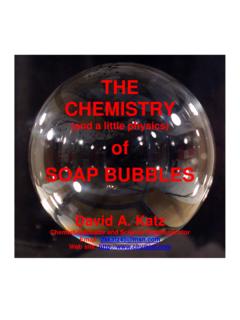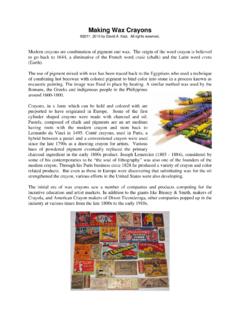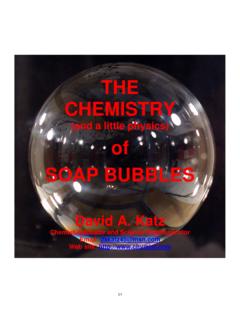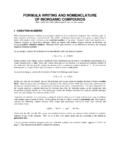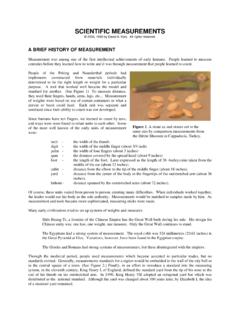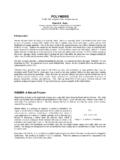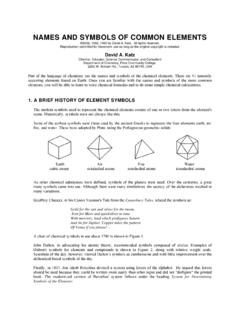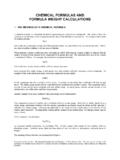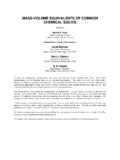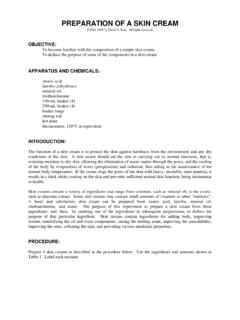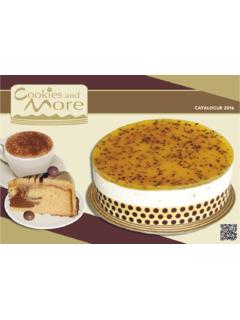Transcription of How yeast works 2011 - chymist.com
1 HOW yeast works . 2011 , 1997 by David A. Katz. All rights reserved. Reproduction permitted for education use provided original copyright is included. Materials Needed active dry yeast , 6 packages or a jar of bulk yeast sugar flour water, warm artificial sweetener such as Sweet'N Low or Equal . measuring spoons 50-mL graduated cylinder or measuring cup. Zipper-lock type plastic bags, quart size plastic wash tub or bucket a marker to write on the plastic bags optional: cookies such as vanilla wafers, or similar (not sugar coated and no fruit or filling). Note: This experiment can be made more quantitative by using a SAVI/SELPH volume tube, (available from Lawrence Hall of Science, Berkeley, CA) to measure the volume of each bag at the conclusion of the experiment. A home-made volume tube can be made using a 1-Liter bottle from a soft drink or bottled water.
2 (See instructions in this experiment.). Safety Safety glasses or goggles must be worn in the laboratory at all times. If this experiment is performed in a chemistry laboratory, all work surfaces must be cleaned and free from laboratory chemicals. After cleaning work surfaces, it is advised to cover all work areas with aluminum foil or a food-grade paper covering. All glassware and apparatus must be clean and free from laboratory chemicals. Use only special glassware and equipment, stored away from all sources of laboratory chemical contamination, and reserved only for food experiments is recommended. There are no safety hazards associated with the materials used in this experiment. Disposal Generally, all waste materials in this experiment can be disposed in the trash or poured down the drain with running water. All disposal must conform to local regulations.
3 1. Procedure Obtain 5 quart size zip-lock type bags and label them: Bag #1: yeast Bag #2: yeast and water Bag #3: yeast , water and sugar Bag #4: yeast , water and flour Bag #5: yeast , water and artificial sweetener (Note: use a saccharin-type sweetener such as Sweet'N Low or aspartame-type [NutraSweet ] sweetener such as Equal . As an alternative, use both types of sweeteners in separate bags.). Add the following materials to the labeled bags: Bag #1: 2 tsp. yeast Bag #2: 2 tsp. yeast 50 mL warm water (1/4 cup). Bag #3: 2 tsp. yeast 1 Tbs. sugar 50 mL warm water Bag #4: 2 tsp. yeast 1 Tbs. flour 50 mL warm water Bag #5: 2 tsp. yeast 1 Tbs. sweetener 50 mL warm water (Note: a 1/4 ounce package of yeast contains 2-1/4 teaspoons of yeast . 1 Tbs. sweetener is 3 packets of sweetener). Carefully, without spilling any of the contents, squeeze out as much air as possible and seal each bag.
4 Put the bags in a warm place for 15 to 30 minutes. Observe the bags periodically. (Note: If a warm place is not available, a plastic wash tub or bucket containing warm water, about 40 C (104 F) can be used.). After at least 15 minutes, remove the bags from the warm place and observe them. What changes have occurred? If a volume tube is available, measure the volume of each plastic bag. What can be concluded about the action of yeast on the substances used? Further Investigation Baking initially increases yeast activity, then kills the yeast as the temperature reaches 60 C (140 F). The heat then causes the starch in the dough to gelatinize and protein chains to align and form rigid bonds. What would happen if a baked food, such as a cookie , is exposed to fresh yeast ? Use zipper-lock bag #1 from the investigation above. (This was the control with yeast only.)
5 Add one crushed cookie , and 50 mL of warm water. Squeeze out as much air as possible and seal the bag. Place it in a warm place for 15 to 30 minutes. Observe the 2. results. Note: If Bag #1 from the previous investigation is not available, use a zipper- lock bag and add 2 tsp yeast , one crushed cookie , and 50 mL warm water.). If a volume tube is available, measure the volume of the plastic bag and compare it to your previous results. Make a Volume Tube Obtain a 1-Liter plastic soft drink or water bottle. Cut off the top of the bottle to form a straight cylindrical container. Use a nail or small drill to make two holes near the bottom of the bottle. (These let air escape from the bottle.). Find a bottle or jar, preferable made of plastic, that fits easily into the 1-Liter bottle. Calibrate the 1-Liter bottle as follows: Place the second bottle into the 1-Liter bottle.
6 Using a permanent marker, place a line on the outside of the 1-Liter bottle even with the bottom of the inner bottle. This is the zero mark. Label it 0 . Remove the inner bottle. Pour water into the 1-Liter bottle until it reaches the zero line. Add 50 mL water to the bottle. Draw a line even with the water level and mark it 50 mL . Pour another 50 mL of water into the 1-Liter bottle. Draw a line even with the water level and mark it 100 mL . Continue to add water to the bottle, in 50 mL increments, marking each water level with a line and the total volume of water. You should calibrate the bottle to hold a total of at least 500 mL. To use the volume tube, take a zipper-lock bag, of the type you are using, open it, then close it and seal it (This traps a small amount of air inside, similar to when you use the bag.) Place the bag into the volume tube, press down gently with the inner bottle, then let it go.
7 Read the volume of the empty bag. Remove the empty bag and replace it with a bag from the experiment. Measure the volume similar to the procedure used for the empty bag. Explanation People have been eating yeast breads for 6000 years, but it was not until the investigations of Louis Pasteur in 1857 that yeast was identified as a microorganism. Yeasts are single-celled fungi. About 160 different species are known, with different yeasts useful for brewing, and baking. Some yeast cause human infections and some contribute to food spoilage. 3. Carbon dioxide and alcohol are normal products of yeast metabolism as it consumes sugars. Simple sugars, such as glucose and fructose are consumer first, then its metabolism changes and it consumes complex sugars such as maltose and sucrose. In the presence of oxygen, such as in the early stages of fermentation, the yeast metabolizes the sugars to essentially carbon dioxide and water with little alcohol formation.
8 This is why there is little or no alcohol content in breads and naturally carbonated soft drinks. Did the bag with the artificial sweetener show results of yeast activity? Such a result is unexpected since the artificial sweeteners have no calories and no nutritive value. Saccharin is between 300 to 500 times as sweet as sucrose (table sugar) and aspartame is about 160 times as sweet. Thus, 1 packet of sweetener, containing 36 mg of calcium saccharin (the active ingredient in Sweet'n Low ) or mg of aspartame, should, according to the manufacturers, contain the same sweetness as 2 teaspoons of sugar (8 g or 8000 mg). To make handling of the artificial sweeteners easier, they are mixed with fillers such as nutritive dextrose (Sweet'N Low ) or dextrose with maltodextrin (Equal ). to produce more bulk. The yeast is able to metabolize the dextrose and maltodextrin.
9 References Equal Consumer Affairs, Personal Communication, The NutraSweet Company (telephone: 800-323-5316). McGee, Harold, On Food and Cooking, Charles Scribner's Sons, 1984. Sarquis, Mickey and Jerry, Fun With Chemistry, Volume 1, Institute for Chemical Education, University of Wisconsin-Madison, 1991. 4. HOW yeast works . DATA and RESULTS. Name(s) _____ Course _____. Date _____. Investigating how yeast works Bag #1 Contents _____. Changes observed after 15 minutes: Changes observed after 30 minutes (or longer): Explanation for your results: Note: Save this bag of yeast for the optional experiment described below. Bag #2 Contents _____. Changes observed after 15 minutes: Changes observed after 30 minutes (or longer): Explanation for your results: 5. Bag #3 Contents _____. Changes observed after 15 minutes: Changes observed after 30 minutes (or longer): Explanation for your results: Bag #4 Contents _____.
10 Changes observed after 15 minutes: Changes observed after 30 minutes (or longer): Explanation for your results: Bag #5 Contents _____. What sweetener was used? _____. What ingredients are in the sweetener? Changes observed after 15 minutes: Changes observed after 30 minutes (or longer): Explanation for your results: 6. Optional Experiment: Open Bag #1, from above. Add one crushed cookie , and 50 mL of warm water. Squeeze out as much air as possible and seal the bag. Place it in a warm place for 15 to 30 minutes. Observe the results. What kind of cookie did you use? Changes observed after 15 minutes: Changes observed after 30 minutes (or longer): Explanation for your results: Summary: What factors favor the action of yeast in baking? 7.
